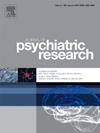Sex differences in long-term fear and anxiety-like responses to deep brain stimulation in a preclinical model of PTSD
IF 3.7
2区 医学
Q1 PSYCHIATRY
引用次数: 0
Abstract
Deep brain stimulation (DBS) is currently being investigated in patients and preclinical models of posttraumatic stress disorder (PTSD), but differences in behaviour according to sex remain elusive. We exposed female and male rats to fear conditioning and extinction. Thereafter, animals were treated with ventromedial prefrontal cortex DBS, followed by a battery of tests to measure fear and anxiety-like behaviour. As in our prior work, animals with high freezing scores during extinction (weak extinction; WE) were segregated from those with lower freezing scores (non-weak extinction; nWE), since the former population was previously shown to develop prolonged fear and anxiety-like responses. Vaginal lavages were collected after fear extinction to study the estrous cycle. After the experiments, brains were processed for the measurement of estrogen (ER) and progesterone receptors (PR) in the hypothalamus and hippocampus. We found that DBS-treated males had a more pronounced reduction in freezing than females during all recall sessions. In females, DBS induced an anxiolytic-like effect in the open field, while a reduction in the latency to feed during novelty suppressed feeding was noticed in both sexes. Noteworthy, a reduction in freezing during recall and anxiolytic-like responses following DBS were observed in males of all phenotypes, but only in nWE females. While no effect of the estrous cycle was noticed on fear memory, DBS-treated females in metestrus/diestrus during extinction had a more prominent response in the elevated plus maze. A similar expression of ERα, ERβ and PRβ in the hypothalamus and hippocampus was found in DBS-treated females and controls.
在创伤后应激障碍临床前模型中,深部脑刺激对长期恐惧和焦虑样反应的性别差异
本文章由计算机程序翻译,如有差异,请以英文原文为准。
求助全文
约1分钟内获得全文
求助全文
来源期刊

Journal of psychiatric research
医学-精神病学
CiteScore
7.30
自引率
2.10%
发文量
622
审稿时长
130 days
期刊介绍:
Founded in 1961 to report on the latest work in psychiatry and cognate disciplines, the Journal of Psychiatric Research is dedicated to innovative and timely studies of four important areas of research:
(1) clinical studies of all disciplines relating to psychiatric illness, as well as normal human behaviour, including biochemical, physiological, genetic, environmental, social, psychological and epidemiological factors;
(2) basic studies pertaining to psychiatry in such fields as neuropsychopharmacology, neuroendocrinology, electrophysiology, genetics, experimental psychology and epidemiology;
(3) the growing application of clinical laboratory techniques in psychiatry, including imagery and spectroscopy of the brain, molecular biology and computer sciences;
 求助内容:
求助内容: 应助结果提醒方式:
应助结果提醒方式:


